#headcanon worldbuilding
Text

LoL fan design - Broodmother Nixale #2
It is a misconception to believe broodmothers are the largest brackern out there. Although their size can very easily eclipse mid-sized towns on Runeterra, it happens often that even their own children outgrow them. Broodmothers only have to be big enough to effectively provide shelter for an entire brood of bracklings at a time. They are similar to scorpions, as they too carry their young on their back, but unlike scorpions, a broodmother would rather starve herself to death than to cannibalize her own. Despite their dedication, not all of their children get to live to adulthood, although the survival rate is of course far larger than that of the orphan born. Their offsprings are called “ra-tehn”, brood born.
---
Plot twist: Big Mama Nixale is not that big, actually.
I just like the trope of the big burly hero and his tiny loving mother. It is entirely irrelevant if a broodmother's child will eventually grow to four times her size and at least six times her weight... he will forever be her little pebble.
I have a whoooole bunch of brackern headcanons scribbled down by this point, I hope I can sketch them out eventually ^^
2024.06.08
#lol#league of legends#skarner#broodmother nixale#fanart#character design#brackern#headcanon worldbuilding
25 notes
·
View notes
Text
Realms Beyond Boiling Isles (Pt.1)
Seorheim, Realm of Runes
Demons and Witches of Seorheim adapted the art of Titans’ Glyphs into a set of symbols to direct magic in the long term. However, the true masters of runes are the Dwarves, or Duarwads, in their tongue. The Dwarves are the ruling classes of Seorheim, ruled by a council of six hold-clans(The Clans ruling each of six major holds), with witches and demons serving them as ‘surface laborers’, scouts, and work those more ‘temporal’. Some of the talented witches married Duarwads of lesser noble clans, whose offsprings are called ‘Halflings’, for their magic prowess is halved to the witch’s power and strength halved to the dwarven side. Halflings became mercenaries, expendable vanguards, or underground workers and aided rebellions sometimes.
Kiquilon, Realm of Alchemists
The majority is populated by a variant of lizard people. ‘Lhongai’, Basilisks, and a variant of Witches. It’s ruled by two important figures who are both greatest allies and competitors; Emperor and Shogun/Warlord. The Lizard People’s way of life is with the concept of seven elements (Earth, Water, Air, Fire, Wood, Metal, and Aether), inkling their ways of magic. Their mastery depends on harmony between all the elements and physical-spiritual bonds inside individuals and to nature. Those who mastered all the seven-element controls became a neigh-immortal lifeform; Ryuteng. The witches learned to transfer their magic through their bile sack across the body, creating a blend of martial arts and unarmed magic. This mastery is called “Qi Magic” or “Kimyojin”, and those who control the magic in the body to balance and peak performance are called “Dha-Ong”, as they may age slower and heal themselves quickly, but still mortals. They are also known to create a substance called ‘icepowder’, which reaching enough coldness and moisture will cause an explosion, as well as a magic force-based compass.
Auwsemun, Realm of the Passed, and Umdei, Realm of Necromancy
Once a home of the earliest Witch-dominated civilizations, where its kings worshipped Titans walked among the mortals. However, after the Titans’ fallen one of the archivists promised a crown prince of that time; Neferatum, an immortality rulership after his father’s demise. However, it came with the price of eradicating all the Titan cults and replacing them with a single temple for themselves. His adopted younger brother, Auwaseme, was adopted from a nomadic tribe rumored slain by Neferatum’s grandfather, who believed the Archivists would destroy the realm and corrupt Neferatum into their pawn.
Auwaseme fled away with seven other tribes related to his kins, along with loyalists of the old kingdoms to the deserted side across the river. A few years later, Neferatum ran out of patience, poisoning his father with the Archivist’s dark magic that made him rotten alive in a minute.
As Auwaseme built his new realm around the scattered oasis, he had a vision of the dying Titan and his ancestors in a dream. The Titan figure called herself ‘Mama Titans’, as she warned that Neferatum had captured people of the Titans’ faiths as a sacrifice for his cursed immortality, and if he succeeded, he would become Archivist in mortal flesh.
Auwaseme, gathered the warriors of six other tribes and Medjais who were loyal to the Titans and marched to the capital where he faced Neferatum, embalming himself in a pool of blood, ground bones, and Titan’s blood. The armies of Umdei, the new nation that emerged over the old realm, are smaller in number but grow stronger with each kill and consumption of dead.
Auwanseme broke the hoard of reanimated dead through his brother, prepared to kill him with the sword of his blood uncle, and revealed its place by the vision a week before. The fight ended up with both severely injured, as Auwaseme later passed away from blood loss. He wished to be buried in a Pyramid in the town he built. Neferatum, meanwhile, could not truly go to the afterlife, but not fully godly, and turned into the savage, blood-thirsting alpha of his new breed; Nosferatu. Disfigured and unable to speak, but retain their wisdom, memory, and cunning nature, dwelling in their abandoned cities, or ruling over the vampires that survived the crusade.
Monarchs of Auwsemun after Auwanseme are buried in the same pyramid along with the first king himself. Inside the pyramid are allowed only three groups of people who may enter and leave as mortals; the high priests, the monarch in time of need, or the herald of Titans. The Pyramid holds all the wisdom of all the kings, even reaching ancestors of Auwsemun or some of the Titans. To ask for their wisdom must either be in dire need or have a worthy tribute offered.
Atlantis, the Grand Port City-State.
A circular artificial ‘island’ and its branches reaching out of the original stone construct emerged out of the water, bringing exotic beasts like elephants, zebras, horses, chickens, and doves and ‘round-eared people’ who ruled the city-state. The first lady of Atlantis recorded in Demon World history was Althemise “the feeding mother”, who claimed a throne after her father’s decease from ‘sudden sinking’ from the Mediterranean to the new realm. Althemise claimed she descended from Poseidon, a deity of the ocean that was not boiling, yet contained life. Althemise married a pirate from pre-unification Boiling Isles, giving birth to a half-witch son named Deusnos “the golden hand”.
With her unique products from Earth; grains, livestock, fish, peacock feathers, olive, and a sample of spices from India, her city-state attracted merchants, but also pirates. Her husband, Ivoryeon, trained the locals to fight like war-hardy pirates, while Althemise’s younger brother taught them the tactics and arms of Athenians. The new navy had introduced and defended Atlantis since then.
Poseidon, part of the Olympians, became a patron god of Atlantis and was reimagined as an Ichthyocentaur with a trident-like staff and ears of horse. After a few reigns passed, the merchants took over the dynasty and dissolved it, assigning themselves to a council of guilds. One main reason Atlantis remained a loose single city while the navy turned mercenaries, the council had no firm leaders, and crimes were common because the guilds are afraid to show their disharmony and risk being attacked by outsiders.
Woodhenges’ Teat, Domain of Druidry
Being home to the witches’ variant known as Drayidans, or simply, the Woodhengers, is not only home to these tribal apex hunter-gatherers and treasure of their sole goddess; Gayaan, but also her temple and her body. Some scholars believed she was a Titan who passed away and thick woods grew on her dead. However, the tribes claim Gayaan is alive, but sacrifice herself not moving to let them reap her life and return it to her when it’s their time. They claimed in the depth of ‘heart mountain’, going deep enough can make them hear her heartbeats.
The Drayidans also forge racial alliances/oaths with the Trees-those-walk, or Entrii, in their tongue. The Entrii lived before the Drayidans, which made them servants to Entrii, in a trade of their fruits to be eaten, their wisdom to learn, and their dead bodies for woods. Meanwhile, the deceased Drayidans must given their bodies to feed the Entrii.
Drayidans rejected to form permanent settlements or let anyone do it on their domains. Their strongest material is a mixture of sap and obsidian shards burnt in the firepit, called woodsteel. They rarely trade or negotiate with outsiders, seeing themselves as children to Gayaan and her guardians from outside taints. They don’t consider themselves the same kin as witches, especially after Belos attempts to conquer their land for Titan’s blood. The war was called by them as Goldantler’s Damnation, slaying several Entrii and Drayidans, ending in stalemate or phyricc victory.
#the owl house#toh worldbuilding#boiling isles#demon world toh#toh au#toh headcanon#toh lore expansion#headcanon worldbuilding
7 notes
·
View notes
Text
Additional notes about netherborns and related species:
Netherborn ≠ Blazeborn, Galeborn ≠ Breezeborn
Blazeborn and Breezeborn are both constructs/machines that are more human-like compared to their mob counterparts.
Netherborn and Galeboen are the player-types that originally lived/made strongholds and trial chambers respectively. They also made Blazeborn and Breezeborns.
This has been on my mind literally since I mentally designed Tango and compared him to our o!Jack Manifold since Jack's a blaze while Tango isn't.
4 notes
·
View notes
Text
Word Count: 313
Reblogs > Likes
---------
Corruption of code happens often, it is why people sometimes don’t respawn, but that’s not what happened here. No, absolutely not.
Corruption is not what caused the people to get trapped, not what caused them to warp into new beings. It is what happened around them though.
No one knows when it began, it had to be before the Nether was shut off due to the Withering infection though. Which meant a long time. One day it was an idyllic land above the Overworld, the heavens as people grew to call them. Above everything, normal players down below and those with abilities of flight high above.
Then, one day, their insect-like wings broke. They could not fly. But that was fine, they didn’t need the Overworld anyway, they were to be gawked at.
Another month passed, no one seemed to notice that some islands had been disappearing. People had been disappearing for months already, they didn’t have wings so why should they worry? Just another doomed soul fallen to the ground far below.
But there was no ground below.
Days disappeared, plants growing gnarled without the sun. They hadn’t seen the moon in years? Decades? When had a century passed?
And those fruits, the dragon, everything. No living being knew when it all happened, they’d angered some god or became part of their own experiments. They didn’t have skin, they had scales. Tails and claws grew. Nothing remained over the insectoids, their wings were torn off a long time ago.
Their airships, their cities, everything they had with their once beautiful sky dwelling empires was gone. They’d abandoned it. They were no longer human after all, they were no longer independent beings.
They listened to the dragon, she was their mother. She shaped them, cared for them, loved them.
No, this wasn’t truly corruption, at least that is what they always told themselves.
#written on: nov 8 2022#not maintagging this because i dont feel like it#nov 21 2022#our writing#headcanon worldbuilding
6 notes
·
View notes
Text

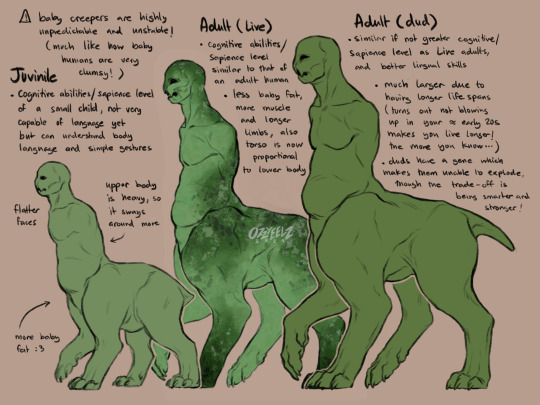

Some creeper concepts that I never posted here :P
#pspsps Mojang… hire me to remake the Minecraft movie#art#digital art#my art#eelz artz#my artwork#fanart#creature design#minecraft#mineblr#minecraft art#minecraft fanart#minecraft creeper#creeper#creeper minecraft#minecraft fandom#creature concept#worldbuilding#minecraft headcanons
3K notes
·
View notes
Text

Peoples of minecraft redrawn
#minecraft#mineblr#minecraft art#my art#minecraft fanart#minecraft headcanons#minecraft lore#minecraft steve#minecraft piglin#minecraft villager#minecraft illager#minecraft witch#minecraft enderman#worldbuilding#my minecraft lore
3K notes
·
View notes
Text
Tribal variations (headcanon): part 1(?)
Icewings

The tribes live on quite large territories, and I think that within them there are different variations that differ in mentality and colours. Decided to start with icewings! I hope I will continue to do this. Who would you like to see next: skywings, seawings or leafwings?
#wof#wings of fire#драконья сага#dragon#wof headcanon#wof worldbuilding#wof confessions#wof icewing#digital art#my art#wof oc
1K notes
·
View notes
Text
PYRRHIA
*Alt text available!
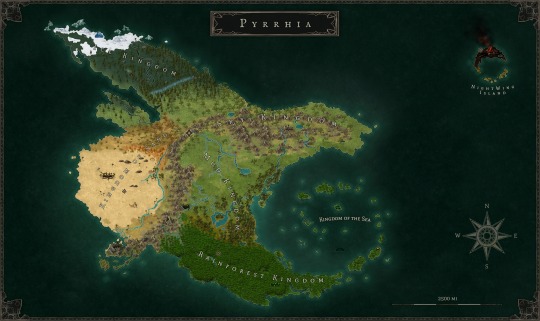

Roughly 1.5x the size of North America, Pyrrhia is the largest continent inhabited by dragons.
Despite it's monumental size, very few areas on the map are considered un-owned territory, with even fewer areas being considered unexplored entirely.
Thanks to the continent's huge climate range, Pyrrhia has the most dragon tribe diversity of any landmass, hosting seven tribes in their entirety.
This includes: SkyWings, IceWings, SandWings, MudWings, RainWings, NightWings and SeaWings.

IceWing Territory

The Ice Kingdom, inhabited primarily by IceWings, is a large peninsula in the far north, also including a smaller cape just slightly south. It borders both the Sky Kingdom and the Kingdom of Sand.
While a large portion of IceWings live within the walls of the Ice Palace (an extravagant city compared to most other palaces), the majority live in villages and towns along the Ice Kingdom's coast.
This is ideal for most, since the primary food source of IceWings are fish & sea-faring birds and mammals. However, it's not uncommon to find an IceWing family or two living further inland, hunting elk and other land-dwelling prey.
While only a relatively small portion of IceWing territory remains snowy year-round, the entire territory all the way down to Where-No-Dragon-Goes-Hungry can be seen blanketed in ice and snow during the winter months.

SkyWing Territory

The Sky Kingdom is home to the SkyWings, and is the largest land-based dragon-claimed territory on the map, give or take. Their territory borders several other kingdoms, including the Kingdom of the Sea, Ice Kingdom, Mud Kingdom, and the Kingdom of Sand.
Being quite physically big and territorial compared to most other dragons, SkyWings demand much more space (and use of such space) than their neighbors, despite there being much fewer of them overall.
By technicality, the Sky Kingdom encompasses the entire Pyrrhian mountain range; although the SkyWings living any farther south than the Diamond Spray Delta tend not to argue about where borders are drawn, so long as they get a good night's sleep.
SkyWings tend to live solitarily or in pairs/family units, with the exception of those living in the Sky Palace working for the current Queen.
Due to this, there are very few dedicated SkyWing towns or villages, with most SkyWings opting instead to pick out an ideal cave in the mountains to call home. This is of course not absolute, and there are many SkyWings living in harmony in bordering towns and cities with other tribes, some being SkyWing dominant.

MudWing Territory

The Mud Kingdom is home to the MudWings; the tribe of the largest land-dwelling dragons in the world. Their kingdom borders the Sky Kingdom, the Kingdom of the Sea and the Rainforest Kingdom.
Despite their size, they actually don't hold the largest amount of territory. Being rather sedentary, they typically never need more than the average pond to themselves and their siblings.
MudWing territory consists of a variety of land types, with the standard swamps and marshes; but also including bamboo forests, floodplains, sparse rainforest and grasslands. This variety in biome gives them plenty of agricultural opportunity, making MudWings one of the largest exporters of both plant and animal produce.
Their rich land also provides an abundance of earthen materials that other tribes covet for their own uses in construction, pottery and other types of craftsmanship; including kaolinite and other clays, calcite, etc!

RainWing Territory

The Rainforest Kingdom is home to the RainWings, the tribe of the smallest and most numerous dragons on the continent. Their kingdom borders the Mud Kingdom and the Kingdom of the Sea.
RainWings live communally, and thus are not separated into several towns. Rather, all RainWings (for the most part) share a single village that extends quite far throughout the rainforest, held together by the Queen's Royal Pavilion (marked on the map as the RainWing Village).
Although, since the events of the NightWing exodus from the Volcano, there lies a single other village amongst the jungle. Some RainWings find it comfortable enough to live there with the NightWing refugees, but don't prefer it.
The rainforest is a dragon's ultimate destination for near any kind of exotic fruit, flower, or animal. While RainWings used to be the top exporter of their tropical produce, these days the MudWings have taken on the task of growing orchards and vineyards, while the RainWings keep to themselves.

SeaWing Territory

SeaWing territory, home to the SeaWings, is technically the largest dragon-claimed territory on earth; this is because the vast majority of their inhabited space is underwater, and thus there is very little competition for territory. The land they control however, is the smallest compared to any other tribe, consisting mostly of small islands and islets.
Their territory borders the Rainforest Kingdom, Mud Kingdom and Sky Kingdom.
Despite being the largest kind of dragon on the planet, they are incredibly numerous due to the abundance of food and territory.
SeaWings live communally, but are spread across several habitable zones, including the Deep Palace and Summer Palace (their primary homes), and various island caves, huts, deep sea trenches, and sea stacks.
They are also partially migratory, spending warmer springs and summers in the Summer Palace, and living deeper underwater through autumn and winter.

SandWing Territory

The Kingdom of Sand, controlled by the SandWings, is the third largest land-based dragon territory on the continent. Consisting of vast dunes and open savannas, this desert environment isn't suitable for most other tribes.
Their kingdom borders the Sky Kingdom and the Ice Kingdom.
Despite their large quantity of land, SandWings are actually not very high in population; more than SkyWings or especially NightWings, but fewer than most.
SandWings are largely nomadic, not living in one particular place for their whole lives; instead relying on sparse oases and rivers spread throughout the desert, and traveling around for food.
Some SandWings, particularly those seeking refuge and safety from war, may choose to spend most of their time in small cities like the Scorpion Den, or border towns like Possibility and Sanctuary. Even then, many prefer to stay on their feet and travel often, reserving their town homes for sleep, rough weather or retirement.
Similarly, many SandWings working for royalty may choose to live in the Stronghold.

NightWing Territory

NightWing territory, the smallest and most uninhabitable, is home to the declining population of NightWings. It does not directly border any other kingdoms, but does have an animus-conjured portal to the Rainforest Kingdom.
Despite all the odds, NightWings manage to survive here on the small (near completely ash-polluted) ponds dotting the island, and by using desalination devices to convert seawater into drinkable water.
The prey on their volcanic home is close to non-existent; consisting almost entirely of occasional seabirds, crabs, beached sea turtles, and fish caught far out at sea using nets; although as time goes on, fewer NightWings are in good enough health to carry fish-filled nets back home.
Their fortress is half-collapsed due to a volcanic eruption, and the air is so hot, heavy and sulphuric that one might find it almost impossible to breathe if you hadn't been born there. What a pity.

Version with ALL Points of Interest
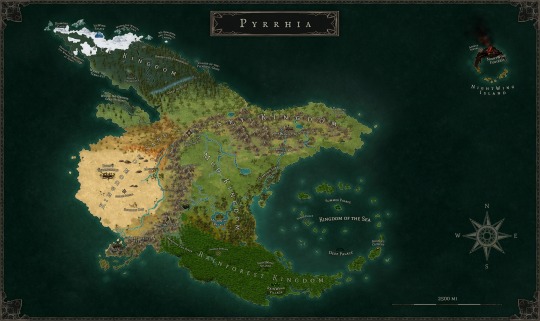
Blank Version

*You may use the blank version of the map for personal things as long as credit to Thorne & I is given! Tag me if you do :D I'd love to see!
This has been in the works probably the longest of anything I've made in relation to my WoF headcanons. I swear I've redone this entire map 3 or 4 times. After a year and a half, hopefully this is the last!!
I hope y'all like it!!
Huge thanks to my friend Thorne for her contributions to the climate placing, I wouldn't have been able to make it look at ALL natural without her help.
If you have any questions or suggestions for edits/additions please let me know! My ask box is open too.
#wof#wof: pantheon#wings of fire#mink's wings of fire#wof headcanon#wof worldbuilding#wof worldmap#worldmaps
1K notes
·
View notes
Text

I’m going insane I want to eat it so bad
#art#my art#minecraft food#minecraft#minecraft headcanons#minecraft lore#lore#headcanons#minecraft worldbuilding#world building#worldbuilding#speculative worldbuilding#food art#food#food worldbuilding#mineblr#spec evo#spec bio#specbio#speculative biology#speculative fiction
1K notes
·
View notes
Text

what if dragon hatchlings were fluffy. what if gumdrops fell from the sky.
#Wof headcanon#my art#oc art#horst#wof art#wings of fire#dragon art#worldbuilding#speculative biology#maybe fuse isn’t the right word. long bones grow post-hatching on cartilage template???
1K notes
·
View notes
Text
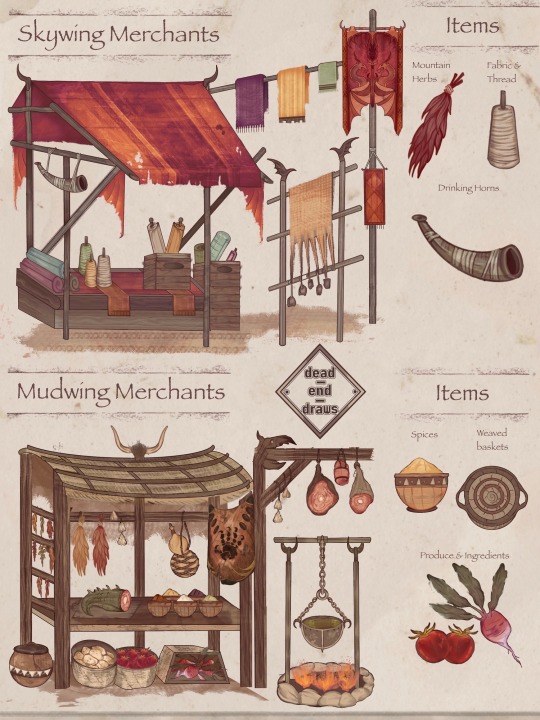

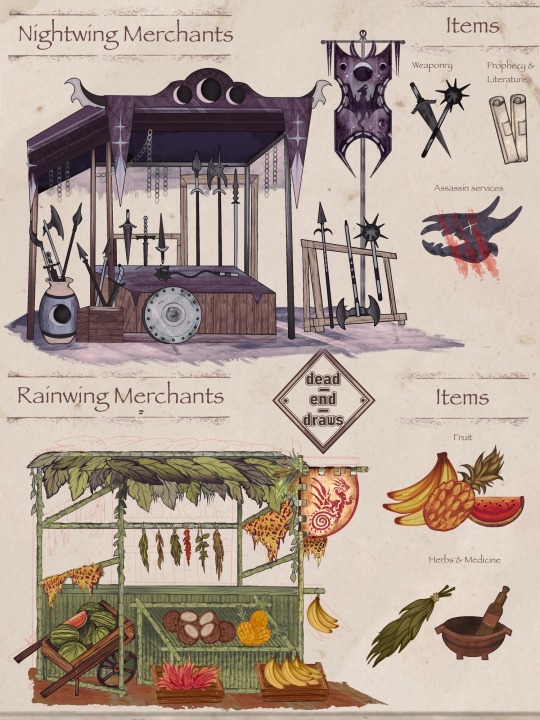
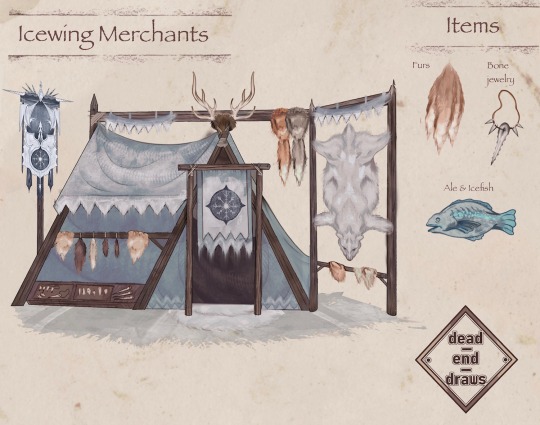
WOF tribe Merchant/Trading booth concepts:
Hey folks! This one was the recent winner of this WOF poll, so here’s my concept art that headcannons trading in Pyrrhia.
Read below cut for close-ups of the individual booths + the thought process / headcannons behind the design choices: 👇
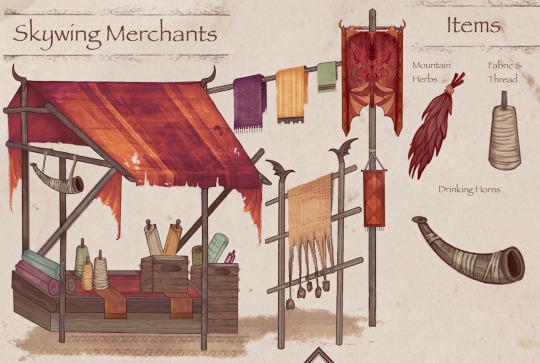
Skywings: The Sky Kingdom’s mountain ranges provide plenty of pasture for raising sheep. As such, Skywing shepherds benefit from traveling to sell their wool, dyes, fabric, and woven tapestries. Many of these merchant tables also include herbs grown exclusively in the mountains, or ibex drinking horns that can be strapped on a dragon’s shoulder & carried in flight.
Along with goods, Skywing merchants may offer sewing services to fix tears, burn marks, or other fabric damage. They are sought out for their quality clothing, and most fabric across Pyrria originated from a Skywing’s talons.
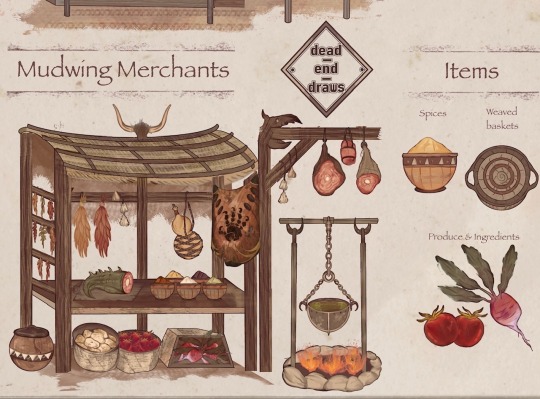
Mudwings: Mudwings’ abundant food & cooking skills are envied almost anywhere in Pyrrhia. Their swamps have fertile soil, responsible for hosting diverse crops which can be purchased as produce at merchant stalls. For those lucky enough to find a traveling Mudwing merchant, the promise of a delicious dish can be whipped up and served at the stall in no time. Along with produce goods, Mudwings sell weaved baskets, spices, and cooking ware.

Sandwings: Sandwing booths offer luxuries of the desert: It’s most common to find accessories such as gold carved jewelry or musical instruments such as drums, lyres, & mandolins for sale. Though, even more sought out across Pyrrhia is Sandwing tattoos/piercings, which are done within the merchant areas. Ink etchings on papyrus paper are stationed outside their tents to showcase designs. All which can be selected, and poked into the skin with a tapping stick and plant dye ink by a trained talon.
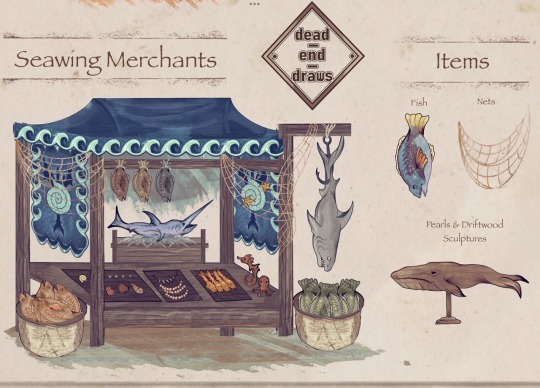
Seawings: SeaWings sell a variety of ocean related goods; taking a share in the fish market with Icewings. Outside of food, there are den decorations like driftwood carvings, accessories such as seashell & pearl jewelry, and rope nets weaved by expert Seawing sailors. Some Seawings even sell fishing equipment, canoes, or offer sailor knot tying instructions to curious dragon buyers.
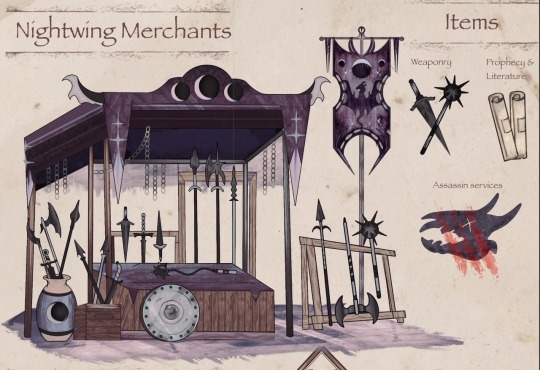
Nightwings: During the war, it was near impossible to find a Nightwing merchant. Most refused to participate in merchant territory, mostly as a way to keep up with their tribe’s mysterious nature.
Though in the more shady, unground parts of the market you can buy from a huge selection of obsidian weaponry, the sharpest in Pyrrhia. No one knew initially how Nightwings smithed so many weapons, or why, until their secret volcano kingdom and the intention to invade the rainforest was discovered. Then forging armor & weapons became clear. Along with a vast armory, for the right price, some Nightwing merchants offer Prophecies & Nightwing Literature (not always guaranteed to always be reliable) and assassin services as well (very reliable).
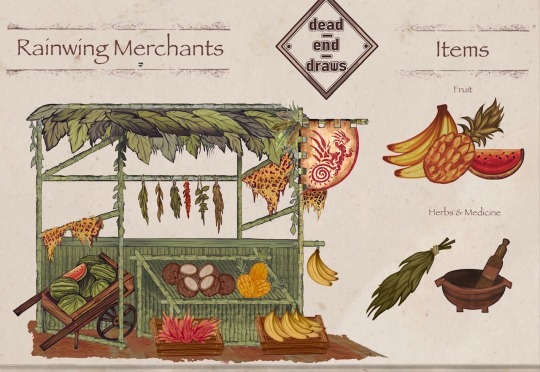
Rainwings: Though Rainwings haven’t been part of Pyrrhia trading for years, they have a vast hold on dragon medicine. An apothecary of herbs, salves, and remedies are all offered for various ailments due to the rainforest’s abundant resources. Along with medicinal goods, many Rainwings are fruit vendors, promising to any hesitant meat-eating dragons that such an array of flavors isn’t to be missed. Though, their fruit selling pitches often fall flat to most other predominantly meat-eating tribes.
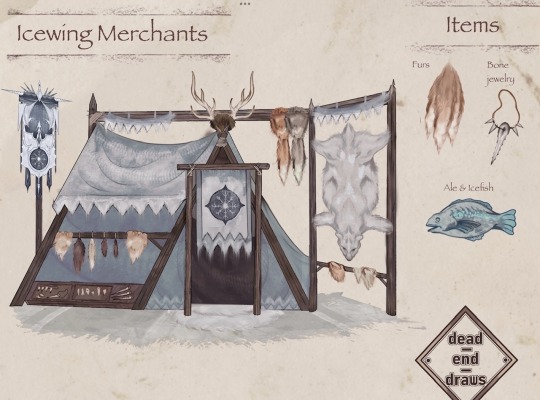
Icewings: Icewings have everything a dragon could need to brace the cold, with a selection of goods only found in the most frigid regions of Pyrrhia. Furs, bone jewelry, and fresh fish (thanks to frost breath) are served on ice. Though Icewings themselves don’t require fur to withstand the cold, it’s considered fashionable and common in upper ranks to wear fur as a status symbol. Since metal is hard to smith without fire & in cold temperatures, fur and bone are more accessible to Icewings for clothing statements.
#art#illustration#bookart#wings of fire#wof#dragon#concept art#concept design#dragons#dragon art#wings of fire art#wingsoffire#wings of fire fanart#wof art#wof headcanon#wof tribes#skywing#Seawing#Mudwing#sandwing#rainwing#icewing#nightwing wof#nightwing#wof fanart#wings of fire headcanons#illustrative art#worldbuilding
3K notes
·
View notes
Text

LoL fan design - Brackern headcanons #1
Ra-xul ("orphan born") are brackern born not to broodmothers, but to ordinary females who abandon them right after giving birth to them. In the cruel world of the Underwell, most ra-xul do not get to live to adolescence, let alone to adulthood. Those that do, are the toughest, most vicious brackern out there who often become the leader of one clan or another as a result. They know how to survive and how to find resources and they aren’t afraid to trample anyone standing in their way to those goals. While adult ra-xul are powerhouses on their own, they usually develop a close bond with whichever clan they become a member or a leader of, and will fight to the bitter end for said clan’s survival. Everything and everyone else outside of the clan is beneath their concern, so much so that leaders are hostile even towards other ra-xul younglings who would be seeking shelter among their ranks. Broodmothers try to adopt those bracklings in secret and integrate them into the clan before the leader could catch on and chase the intruder away.
Ra-tehn ("brood born") are the offsprings of broodmothers who grow up under the protection of their mother and of the clan. They are definitely not as tough and vicious as ra-xul, they are more accepting of outsider brackern, especially if one seeks to join their ranks. But they too are capable of fighting terribly for the survival of their clan and especially of their broodmother. While the ra-xul leader forges the path forward, the ra-tehn ensure all members (ideally) can follow said path.
Not all ra-tehn reach adulthood, of course. Armordillos and other predators, sicknesses, starvation and hostile clans are an ever-present threat in their lives. They also sometimes strike out into the Underwell on their own or in small groups after their second molt to seek a new home, especially if the clan as a whole has fallen on hard times. This almost instinctive migration ensures the creation of new clans, and the refreshing of gene pools. Wandering ra-tehn tend to seek out a new home as far away from the original as possible, to hopefully avoid future conflict with their former family… and Tremors forbid, to avoid harming their beloved mother.
Broodmothers are often strong and well-versed in the natural earth magic all brackern are born with. Despite their relatively lighter weight due to their hollowed-out shells, broodmothers rarely move much, opting to keep vigilance over their scuttling children. This slow life enables them to develop a kind of connection with the earth around them, using it to detect even small dangers such or sounds and movements hundreds of kilometers away. Unfortunately, armordillos have their own brand of earth magic which the more intelligent ones can use to mask their presence from the broodmother just long enough to snatch a brackling away.
---
And I'm off to the US, by the time this sketchdump goes up. This is going to be an interesting two weeks, for sure!
Either way, I have managed to squeeze in some more brackern headcanons, and I hope you guys enjoy them! Who knows, by the time I get back, I might have even more ideas!
... I might have to tackle the fearsome brackern clan wars eventually, once I get back and recover from the trip and the insane flight times.
(Also, not entirely sure about the non-broodmother female's head, I might change the design down the road.)
More League of Legends stuff (and brackern headcanons)
2024.06.22.
13 notes
·
View notes
Text
Worldbuilding Cuisine of Helluva/Hazbinverse by Layers [Headcanon]
The Pride Ring
Being home to most of the sinners, the Pride Ring contains the best(and the most cruel, and the most ‘exotic’) cuisines that exist in all The Rings of hell. Live Sashimi, Ortolans-Foir Gras, mother boar stuffed with her cooked children and left to rot before eaten decomposed, and local eel cooked alive in an acidic and spiced broth. The cuisine, no matter its ‘normal’ version(as a hell-adapted version of Earthly recipe) or the brutal ones, is enjoyed by sinners who believe they don’t have any virtues to lose(and as a coping mechanism for homesickness).
For their ‘creativity’ and struggling beasts being cooked in agony as a show, some middle-class and elite hellborns also enjoy the sadistic feast for the sake of their pride over lesser beings, meals, and shows that give them entertainment, and flavors they may never get to try without arriving on Earth.
Several dishes are also a mockery to the faiths of humanity they fail; Beef Tandoori, Pork and dog meat kebab, and food once considered tributes to the gods of the ancient temples. Dozens of business catering dishes have been forgotten by living humans, a few of them were even a pot of stew that has been cooked since the Stone Age.
Two main aspects of ‘pride’ in the local cuisine are the roots of sinners and demonic nobility, and the expectation for the ‘authentically fine’ dishes. Recipes are invented and kept secret steadily in the pride ring, while demand for better and more luxurious services is always rising. Sinners who have proven their cooking mastery attract Hellborns customers, which may grant them status as personal chefs, business partners, or licenses to work in Gluttony Ring’s Cornucopia Court.
The Wrath Ring
Aspects of animal husbandry, hunting, and wars culturally shape populations of the Wrath Ring. Their food is mostly carnivorous, preserved or cooked to have a long shelf life, and heavily spiced. The Wrath Ring has two main groups of sub-cultures: the nomads and the forgebeasts.
The Nomads rely their life on their mount animals, hunting wild beasts, and taming flight animals(like fiery hawks or midget bat-drakes). Their food mostly consists of preserved meat, cheese, yogurt, and a hardtack-like ration made of foraged wild grains and nuts. Occasionally, especially for successful raids, the birth of strong heirs from powerful families, or the declaration of the new khan, full roasted animals, fermented alcoholic yogurt, and spicy berries-based chutney are involved as a celebration.
The forgebeasts, however, are settled animal farmers and blacksmiths, relying on raid and slaves-growth grains and rooted plants. Spices and meat symbolize the elites as the common warriors mostly rely on offals, rough cuts of smaller animals’ meat, and grains/rooted starch. Spicy food and strong alcohol are locals’ favorite relievers of laboring and oppressive life, especially stew made of potatoes, rooted vegetables, meat, offals, and bones, and affordable spice mixes(Sometimes with sulfur, magmatic rock, or specific acidic mixes) enjoyed with a vodka-like drink. The stew also serves as a reminder of family and battle comradery since meat is usually bought by combining each member’s cash, and the meal is shared from the common cauldron.
Since urbanization and integration between the two cultures, populations of the Wrath Ring formed its outstanding identity; spicy dairy-based dishes with a fondness for spiciness, pungence, and ‘meaty’ savory. One of the most adored dishes of the Wrath Ring is ‘scourged gargoyle’; a roasted full gargoyle/gigantic muscular bat bathed in spicy sauce and aged cheese. More modern approaches are spicy wraps, meal jerky, and sausage-based grab-and-go.
The Gluttony Ring
The breadbasket and orchard of Hell, the Gluttony Ring has not only fed an entire hell(at least those who manage to get it), but it is also known for brewing the best alcohol from various grains, fruits, spices, and herbs. In addition, food products from Earth are being sold there legally. In addition, the sinners and hellborns alike who are the best in culinary are usually found in Cornucopia Court; a complex building combining restaurants, supermarkets, fresh markets, cooking suppliers, and food stalls.
With combinations of ingredients local to hell, imported supplies from Earth, masters of cooking in various origins, and constant high demand for the gourmet, the Gluttony Ring becomes a breeding ground for creative and rich cuisines. Unlike the Pride Ring, food is valued as nourishment and performance to witness by aroma, texture, and flavor, rather than unrelated overt decor and screaming of live ingredients. Plus, rather than the essence of the ancient recipes and stories of the dish, the food of the Gluttony Ring is focused on aspects of business, culture, honor, nourishment, and innovation.
From all-you-can-eat Full English Breakfast Buffet(it is quite a challenge to traffic black puddings and baked beans without raising an eyebrow at Earth’s authorities) to a hell’s adaption of Paletas, there are ten thousand food businesses on the ring. There was a saying “There is always a feast you dream of or need in the Gluttony Ring. You may just not find or be aware of it yet.”
However, the spotlight of the Gluttony Ring is on all-you-can-eat buffets, offering different cuisines and price ranges. Unlike the Omakase/tailoring dishes culture that is more common in the Pride Ring, Gluttony Ring’s meal focuses on getting great food with good numbers at affordable prices.
The Greed Ring
Fast, Cheap, and Decent; are the only requirements(yet, crucial) for a functional food business in the Greed Ring. The food is rarely ‘cooked’, but mass manufactured, lab-synthetized, or recycled. Each standardized meal is packaged in preserved conditions, requiring only temperature, microwave oven, or boiling water(or any edible fluid), if needed. Not only can they be made steadily in numbers, nutritional supply is expected to be consumed quickly, yet, not too nourishing to keep the consumers buying it often.
“Ingredients” are mostly ‘digested’ leftover biomass(sawdust, moldy fruit peels, meat from a cemetery, and thick slime from sewer), broken into basic, simple nutrients while eliminating contamination by converting them into part of the ingredient paste. There are five types of ‘ingredient paste’; budget(minimalized processes and has a chemical aftertaste, but is very cheap), plain(removed most flavor and odor, with some nutrient values), filler(plant fiber-based, made of sewer algae and plant-based trash), savor(tastiest and the most expensive, made of fresh bodies of rats, insects, pest animals, and locals), and gel(lubricant-like, make consumption faster and less disgusting taste. Also good for sauce base).
Ingredient paste is later flavored and kneaded into artificial texture, sorted for each sync-fresh ingredient, before reassembling them into packages. Most products barely have food-like characteristics, are over-seasoned with a numbing taste beyond savoring, and have slimy dough-like texture. However, the population of the Greed Ring lives on under minimum wage and intense work.
The Lust Ring
The culinary arts of the Lust Ring are founded on intense flavor and aroma for those benumbed tongues and throats of drugs, sex, and sensation-exposed hellborns. Whether sweet, salty, acidic, bitter, spicy, or savory, the flavors are meant to be strong and harmonized. Fruits, chocolate, seafood, or some specific herbs, spices, and mushrooms are featured in every dish in the Lust Ring, and at least a few of them together make an ideal food for the lusty dwellers.
Vitamins, Minerals, Lean Whey Protein, and Artificial flavonoids play a major part in lust ring, where calories and nutrition are taken seriously to maintain stamina and appeal. In addition, hell’s version of collagens, zero-calorie fillers, and meal pills are invented after the concept of human nutrition sciences. Before the appearance of modern sciences, people of the Lust Ring relied on greens, fruits, insects, and ‘filler’ like jellyfish drakes, edible sponges, or konjac-like plants.
Despite a focus on quick consumption, unlike the Greed Ring, Lust Ring’s cuisine offers more varieties of meals; salad wrap, smoothie, veggie bowl, and fruity bar. Its food manufacturing is less massive and more ‘tailoring’; it’s mostly customized to customers’ requests by nutritional and flavor preferences. Some kiosk machine franchises from the Greed Ring are featured, but middle-class and upper-income ones prefer to buy their food from local businesses they know by persons.
In addition, the culinary knowledge of the Lust Ring is less art and more sciences; nutrition, medicines, beauty maintenance, and performance demand the food service industry to nourish local hellborns without excesses or malnutrition. A few local universities even established specific schools for nutritional sciences, physical maintenance medicine, beauty pharmacy, etc.
The Envy Ring
Composed almost two-third as a water body by area and most of them are saltwater or acidic seas, local foods are mostly made of algaes, aquatic animals, edible mosses, mangrove fruits, and mud-dwelling crustaceans or bugs. They are also known for a variety of preservation-based ingredients, especially fermenting, pickling and brining. The old cuisine features stable/filler made of the salt marsh and edible mud along with limestone-brined acidic sea-originated food, shellfish broth, and mashed bugs. Pickles are featured as ‘flavonoid’, especially as seasonings, dipping, and base for the curries/stews.
‘New’ Culinary Culture of the Envy Ring is considered ‘localized copy attempts’ of cuisines from Pride and Gluttony Ring, while economically influenced by the Greed Ring and Lust Ring. Dishes are heavily seasoned with both organic and synthetic origins, while nutritions are also added to increase its number (also the hidden amount of toxins and harmful components). Examples include seafood(with bugs mash and digested ingredients from the Greed Ring)-based paste shaped and seasoned as skewers, thin and crispy pizza/crepe made of mixture of dough and salt marsh and topped with local sauce and ‘larvae cheese’(made of salted and smashed larvaes), and stuffed bun with ‘stuffing of the day’ that is mysterious and changed daily(or weekly, depend on business flow).
Spices are so rare in the Envy Ring that locals rely on parts of local mangrove plants, synthetic acids, limestone-based flavonoid, and heavily-pickled ingredients. Peppery dishes are mostly eaten privately indoors by the upper classes, especially after ‘the spice revolt’ led by middle-class merchants and local thugs to get share of spices from the nobles and Leviathan’s supporters. Most spices are reused in pickling until it loses all the taste while many working classes never had a taste of peppercorn before.
The Sloth Ring
To cook with minimum labor required, people of the Sloth Ring relied on geothermal cooking, pickling, fermenting, steamed, stewing, and dried their food. One of the most popular ingredients is a block of hardtack, jerky, and dried vegetables that get dehydrated, pressed, and smoked as a preserving method. The food is called ’Brothed Blocks’, which is consumed by putting in a boiling fluid and letting it turn into broth for quick and easy consumption.
The convenience is highly valued in the Sloth Ring, even before medicalization of the society. Cooking is more a business than housework, as specific families or small groups work as cooks and serve locals quick, easy, and decent-tasted dishes. The common ones are ‘One pot stew’, steamed brothed blocks, or tubes of milky and mushy meal. However, time is what the Sloth Ring has more than the Greed Ring for obvious, making them being the best of slow cooking. The tastiest soup, geothermal-baked pulled meat, and steamed bun are mostly in the Sloth Ring. Some local businesses selling stew, soup, or broth claim the pot is always kept full with ingredients constantly running in and cooking slowly but constantly happens.
The ultimate form of food in the sloth ring is a thick soup made of ingredients that had been cooked slightly below boiling points for months and left boiled and untouched. The soup slits into three layers; the foamy and complex umami sheet used as seasonings and reserve only for the special customers/guests, the opaque soup with taste of ‘savory, sour, salty, and oddly tang’, and under the bottom is caramelized(and partly burnt) substances giving other layers slightly smokey and maillard taste. The soup is known as ‘Centurion Cauldron’, and those that are proven to cook for over a century constantly are called ‘Belphaegorite Cauldron’ as honor.
#hazbin hotel#helluva boss#headcanon worldbuilding#worldbuilding cuisine#foodbuilding#vivzieverse#helluvaverse#hazbin verse
6 notes
·
View notes
Text
Good morning I bring a very silly mc headcanon
The reason why chickens can be in the nether is cus Piglins and Netherborn think they're very cute, so they just trade them in from the Overworld.
They have their own special nether-safe breeds and are seen as good childhood pets (even if they kinda aren't)
9 notes
·
View notes
Text
The great thing about canon giving you only vague details about a character is the fact that you can take that character to the Build-A-Blorbo workshop and stuff them with whatever headcanons your little heart desires.
#fandom#blorbos#headcanons#danny phantom#star wars#worldbuilding#fanfiction#fanart#and then you get to sit around and play blorbos with other fans#''omg i love your blorbo's costume redesign!''#''i love your blorbo's tragic backstory!''#''i love what you've done with his hair!''#tumblr is the build a blorbo workshop btw
3K notes
·
View notes
Text



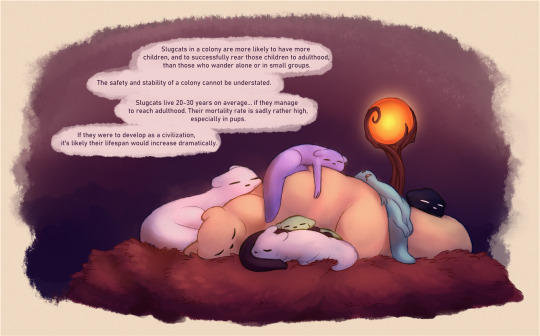
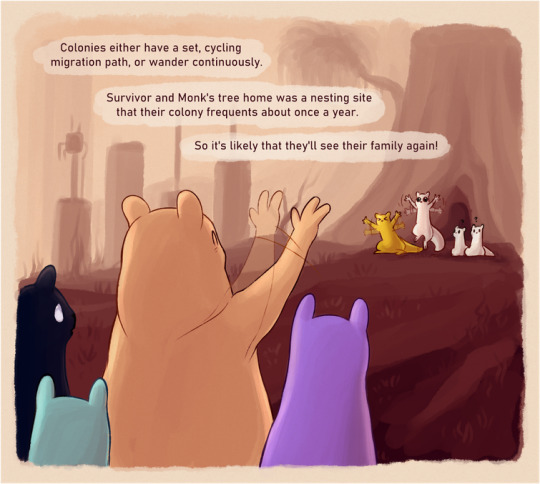


Playing with some ideas mostly regarding gender/reproduction in RW, and slugcat colonies.
Full transcript under the cut!
Creatures in Rain World are typically simultaneous hermaphrodites but require partners to reproduce, with either individual capable of being a genetic donor or carrier. Alongside what we are familiar with, this has lead to interesting reproductive strategies such as rotating donor/carrier roles, or dual/simultaneous genetic swaps.
Rotating donor/carrier roles - A K-selection reproductive strategy. One partner carries the first child, the other partner carries the next child, and so forth. Allows each partner to recover from the demands of childbearing.
Rain Deer aren't quite monogamous, but they tend to choose the same breeding partner whenever mating season rolls around. They serve as a donor one season, then bear and raise a child the next. Calves are raised away from the rain and worm grass, in places that have less food but more safety. Calf wool is softer, not yet gunked up by the dirty rainfall. Their legs are sturdier as children, allowing them to run for cover while the parent wards off threats.
Dual/simultaneous genetic swap - An r-selection reproductive strategy. Parents fulfill the donor and carrier role for each other. The more children you make, the more likely some are to survive!
Multiple batflies lay thousands of eggs in a single "blue fruit." Several eggs congeal and become nutrient paste for the surviving eggs (and for hungry slugcats). Like some plant seeds, batfly eggs that are consumed before pupating can survive passing through the digestive system. Ew.
Ancients also fell under this umbrella. Their genders (and the genders of iterators by extension, who have no sex anyways) could have been determined by a variety of other factors, such as societal role, donor/carrier preference, or simply different categorizations of personal expression.
It's difficult to say how well their common pronouns would translate to ours, but it seems they can translate to an extent, given what Moon and Pebbles use canonically.
Slugcats, like real slugs, can have children with a partner or self-fertilize. Unlike real slugs, they are often known to adopt.
In the case of self-fertilization: children who are born from one parent may display a large amount of genetic diversity despite the circumstances. Maybe slugcats have some sort of... genetic reservoir independent of their own genetic code?
Slugcats live 20-30 years on average... if they manage to reach adulthood. Their mortality rate is sadly rather high, especially in pups. If they were to develop as a civilization, it's likely their lifespan would increase dramatically.
Slugcats in a colony are more likely to have more children, and to successfully rear those children to adulthood, than those who wander alone or in small groups. The safety and stability of a colony cannot be understated.
Colonies either have a set, cycling migration path, or wander continuously. Survivor and Monk's tree home was a nesting site that their colony frequents about once a year. So it's likely that they'll see their family again!
...also, the strength of large colonies are why scavengers are likely to become the dominant species. In the time of Saint's era, continuous migration has become more of a risk, and it has become more difficult to support large populations. Slugcat populations have shrunk back to the more forgiving equatorial zones.
Saint's tongue is pretty unusual and probably unique to them, or to a small population that they hail from. Fur (of varying thickness) is much more common.
Meanwhile, scavengers are bulkier and covered in thicker insulating fur. They:
have seemingly massive populations
have a burgeoning society (the existence of merchants, tolls, bartering, elites and leaders)
are adept at communicating (non-verbally)
manipulate their environment
can build structures (scavenger-made structures were a scrapped idea from Saint's campaign)
can create complex weapons and tools
may have agriculture behind the scenes (unsure if scout parties prioritize exploration or hunting)
I would wager on scavengers developing more quickly than slugcats, but it would be nice if there was a future where both could co-exist.
#oops! impromptu rendering practice!#rotating donor/carrier roles could also be an r-selection strat#but i feel like it'd be more common as a k-selection strat#rain world#worldbuilding#headcanons#flickerdoodles#art#um#ask to tag?#that goes for all of my posts#rw spoilers#dp spoilers#saint spoilers#long post
2K notes
·
View notes